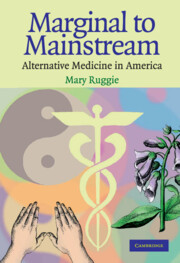Book contents
- Frontmatter
- Contents
- List of Tables
- List of Acronyms
- Preface
- 1 Introducing CAM … and the Many Questions It Raises
- 2 Understanding CAM: The Problem of Knowledge and the Power of Words
- 3 The Growth of CAM: Patterns of Use and Meaning
- 4 Physicians: Learning New Ways
- 5 Medical Research: Science and Interpretation
- 6 Investigating CAM: What Works?
- 7 The Road Ahead: Accommodation or Integration?
- Bibliography
- Index
7 - The Road Ahead: Accommodation or Integration?
Published online by Cambridge University Press: 05 June 2012
- Frontmatter
- Contents
- List of Tables
- List of Acronyms
- Preface
- 1 Introducing CAM … and the Many Questions It Raises
- 2 Understanding CAM: The Problem of Knowledge and the Power of Words
- 3 The Growth of CAM: Patterns of Use and Meaning
- 4 Physicians: Learning New Ways
- 5 Medical Research: Science and Interpretation
- 6 Investigating CAM: What Works?
- 7 The Road Ahead: Accommodation or Integration?
- Bibliography
- Index
Summary
The preceding chapters set out to answer certain questions: what is CAM, why are so many people using it, why is this growth occurring now, how is the relationship between CAM and medicine changing, and what consequences will any of this have for health care. In answering these questions, I have outlined at the same time a remarkable change within the last several years in the status of CAM. It has moved from being a vaguely understood collection of marginal and, per some people, disreputable practices to being a mixed bag of practices – some are better understood and becoming valued, others are still fuzzy and unimpressive. There have been a number of drivers behind this change in status: users of CAM, physicians, researchers, insurance companies, and government. All are making distinctions among different alternative therapies and selecting certain therapies for further exploration. Each set of actors is drawing on different but related kinds of knowledge as they engage in these activities. The result is a mainstreaming of certain therapies – those that people are using; that physicians are recommending and, in some cases, practicing; that researchers are investigating and finding to be safe and effective; that insurers are reimbursing; and that government is supporting through NIH funding for research. I turn now to the task of pulling these strands together, highlighting the role of each of these main actors, and weighing their relative contributions to the process of mainstreaming.
- Type
- Chapter
- Information
- Marginal to MainstreamAlternative Medicine in America, pp. 184 - 202Publisher: Cambridge University PressPrint publication year: 2004



